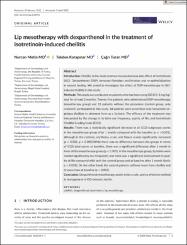Lip mesotherapy with dexpanthenol in the treatment of isotretinoin- induced cheilitis

View/
Access
info:eu-repo/semantics/embargoedAccessDate
15.04.2022Metadata
Show full item recordCitation
Metin, N., Karapınar, T., & Turan, Ç. (2022). Lip mesotherapy with dexpanthenol in the treatment of isotretinoin‐induced cheilitis. Journal of Cosmetic Dermatology.Abstract
Introduction
Cheilitis is the most common mucocutaneous side effect of isotretinoin (ISO). Dexpanthenol (DXP) increases fibroblast proliferation and re-epithelialization in wound healing. We aimed to investigate the effect of DXP-mesotherapy in ISO-induced cheilitis in this study.
Methods
This study was conducted on patients who had been using ISO (0.5–1 mg/kg/day) for at least 2 months. Twenty-five patients who administered DXP-mesotherapy (mesotherapy group) and 33 patients without the procedure (control group, only ointment) participated in this study. All patients were prescribed only hamamelis virginiana distillate in ointment form as a lip balm. The efficacy of the treatment was interpreted by the change in lip balm use frequency, quality of life, and Isotretinoin Cheilitis Grading Scale (ICGS).
Results
There was a statistically significant decrease in all ICGS-subgroups scores in the mesotherapy group after 1 month compared with the baseline (p = <0.001), although in the controls, erythema, crust, and fissure scores significantly increased (p = 0.001, p = 0.002).While there was no difference between the groups in terms of ICGS total scores at baseline, there was a significant difference after 1 month in favor of the mesotherapy group (p < 0.001). In the mesotherapy group, lip balms were needed significantly less frequently and there was a significant improvement in quality of life compared with both the control group and at baseline after 1 month (both; p < 0.001). On the other hand, the control patients suffered more from cheilitis and dryness than at baseline (p < 0.001).
Conclusion
Dexpanthenol-mesotherapy seems to be a safe, and so effective method in management of ISO-related cheilitis.















